A modest palace is silhouetted against serene Himalayan peaks as a slender man in a white smock over his brocade kho daubs paints on a canvas. His beloved mountains take on imposing shape and form under his brushstrokes. That he is the Chogyal of Sikkim-King who rules with righteousness- is incidental as he smears fantastically allegorical colours with great panache.
History is littered aplenty with kings who were patrons of the arts; they commissioned great works of arts, but rarely did they themselves paint. Chogyal Tashi Namgyal was one of the few kings who displayed a singular finesse for painting.
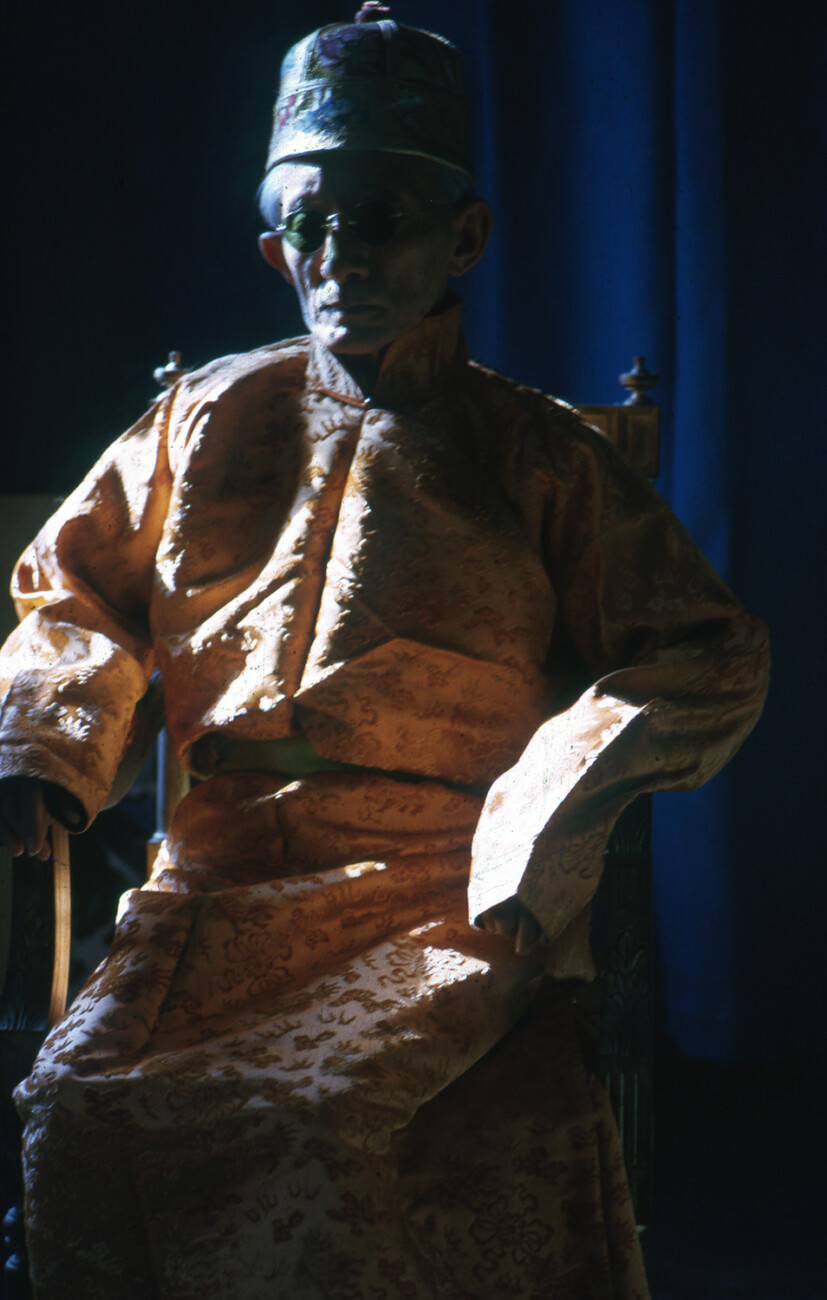
History is littered aplenty with kings who were patrons of the arts; they commissioned great works of arts, but rarely did they themselves paint. Chogyal Tashi Namgyal was one of the few kings who displayed a singular finesse for painting. Born on October 26, 1893, to Their Highnesses, Maharaja Thutob Namgyal and Maharani Yeshey Dolma, Kumar Tashi Wangyal (the name given to him at birth) was the second child and only son out of this union of the ninth Chogyal of Sikkim and his Tibetan consort.
He was educated first at the Bhutia Boarding School in Gangtok, which was followed by a stint at St. Paul’s School, Darjeeling. He later enrolled at the principally-for-Indian princes Mayo College, Ajmer, where he displayed an acknowledged talent for drawing, and gained prizes in English, Geography and Drawing. The Principal reports that he made considerable progress during the year and that his conduct was excellent. (Administration Report of the Sikkim State, 1909-10: 1) However, for six months of the year, during the rains and hot weather, the young Sikkimese prince returned home to Gangtok where he continued his studies under his private tutor, Mr. Bareth Ambadan.
At 21, he succeeded to the Gadi of Sikkim upon the demise of his half brother, Sidkeong Tulku, on December 15, 1914. After the year of traditional mourning, he was formally consecrated as the eleventh Denjong Chogyal in the Durbar Hall of the Palace on May 15, 1916 and invested with full ruling powers on April 5, 1918. He assumed the name Chogyal Tashi Namgyal, with which version we are more familiar today. He married on October 8, 1918, Kunzang Dechen Tshomo, daughter of the aristocratic Ragasha family of Lhasa.
In Tashi Namgyal’s long reign of 50 years, several social and economic reforms saw ‘the country changed from a primitive, feudal state to a modern progressive one’ (Coelho 1967: 33). His eventful rule and busy administration did not however prevent the Chogyal from cultivation of letters and arts, a taste inherited from a gifted mother. Scholars from all over the world, scholars engaged in Buddhist studies as well as scholars engaged in exploring Nature’s bounty in Sikkim had enjoyed his ready patronage...In his private leisure hours, which were not many after prayers and meditations, the Chogyal devoted himself to paintings of landscapes and had developed a style of his own. This stood for realistic representation of the Himalayas focussed to a mystic symbolism. (Sikkim: A Concise Chronicle: 29)
Towards the latter half of his reign, Chogyal Tashi Namgyal increasingly led a semi-retired life, preferring to let his heir, Gyelse Palden Thondup Namgyal, handle the reins of the administration. He spent his time meditating and painting, his preferred medium being oil paints.
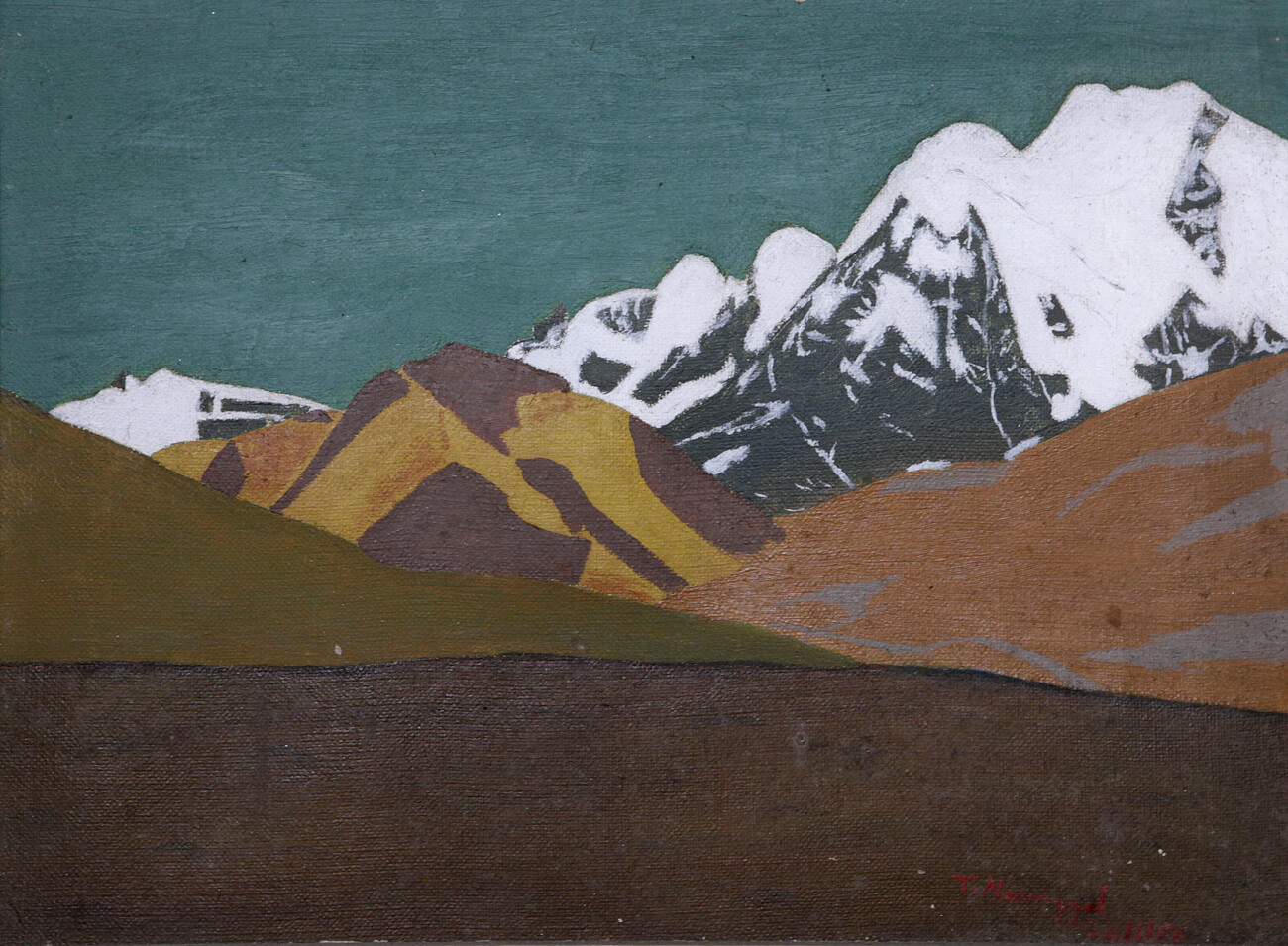
Photograph: Marte Visser.
Towards the latter half of his reign, Chogyal Tashi Namgyal increasingly led a semi-retired life, preferring to let his heir, Gyelse Palden Thondup Namgyal, handle the reins of the administration. He spent his time meditating and painting, his preferred medium being oil paints. He was a self-taught artist of the modern, western school and delighted in the portraying of the majestic snow-ranges of his mountain kingdom. He enjoyed showing his paintings to visitors, but only very rarely would he condescend to part with them. I considered it a very special honour therefore when once, early in the morning on my birthday, there was a tap on my bed-room door and Sir Tashi’s emissary entered carrying in Sir Tashi’s latest creation as my first birthday gift. (Rustomji 1987: 12-13). While a formal record of the paintings he gifted away does not exist, one of his paintings gifted to Pandit Jawaharlal Nehru, can be viewed today in Teen Murti Bhavan in Delhi.
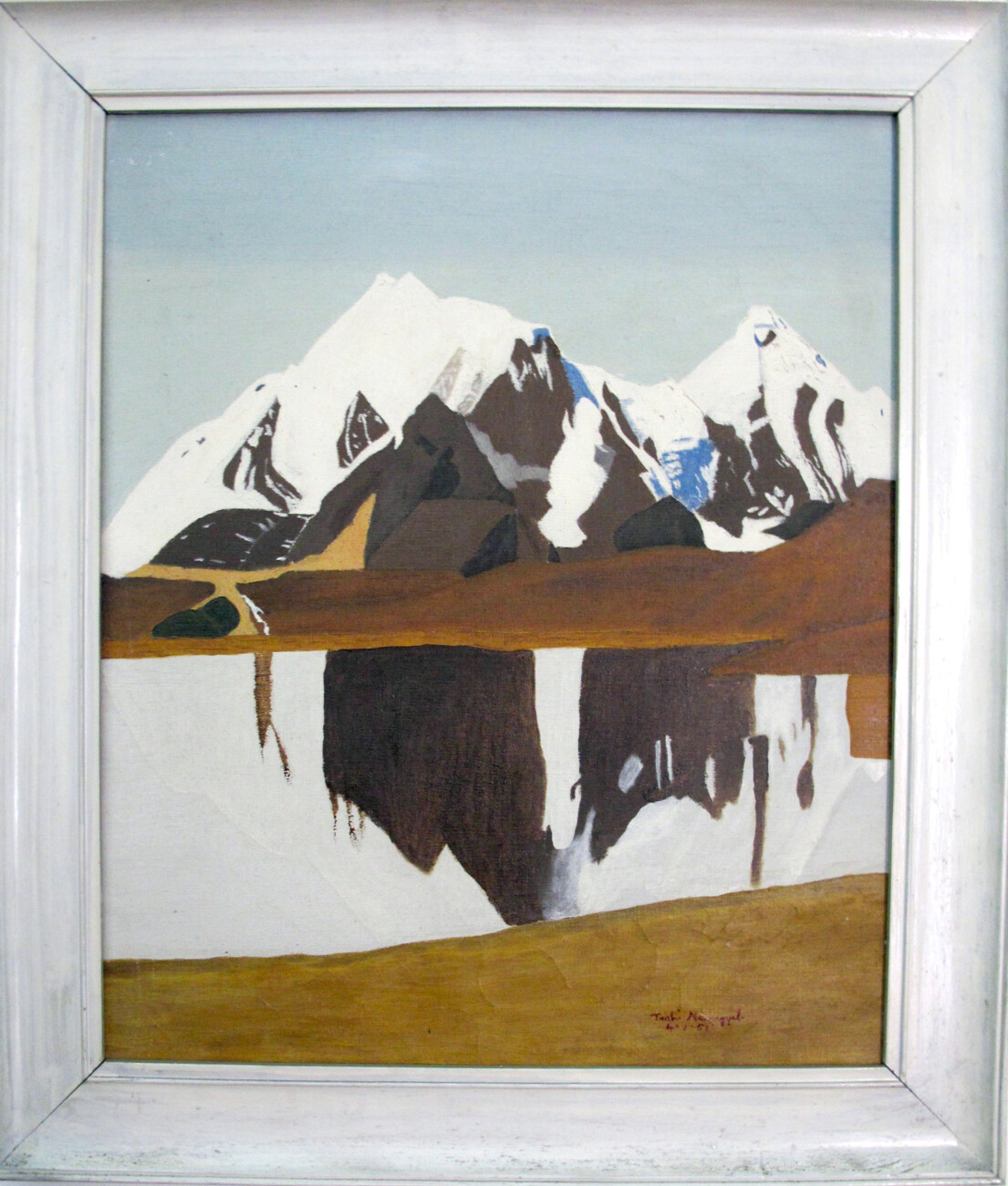
On the January 24, 1961, Indian Prime Minister Nehru inaugurated an exhibition of some paintings of Chogyal Tashi Namgyal. This was the first and only formal exhibition the Chogyal would ever consent to. His Highness parked himself in Delhi with his family during the duration of the exhibition.
The exhibition catalogue explains that the paintings of the Maharaja of Sikkim are an eloquent example of an inspiration derived from the environmental influence of Nature, and are a testimony of a direct communication of experience generated by the grandeur of Mother Nature on a receptive soul.
Further, the paintings of the maharaja are not based on visual impression alone but reflect an awareness and a profound feeling. The graphic expression is the direct result of inner response to the legend of the mountains. The idiom is personal. Colour depict frequently an arbitrariness but are real enough for the visionary painter.
A seeker of truth and deeply religious, art to him is a means of paying homage to the Enlightened One. How simply he says, “I see Devas (Deities) in my everyday prayer. I cannot speak to Them but They speak to me.”
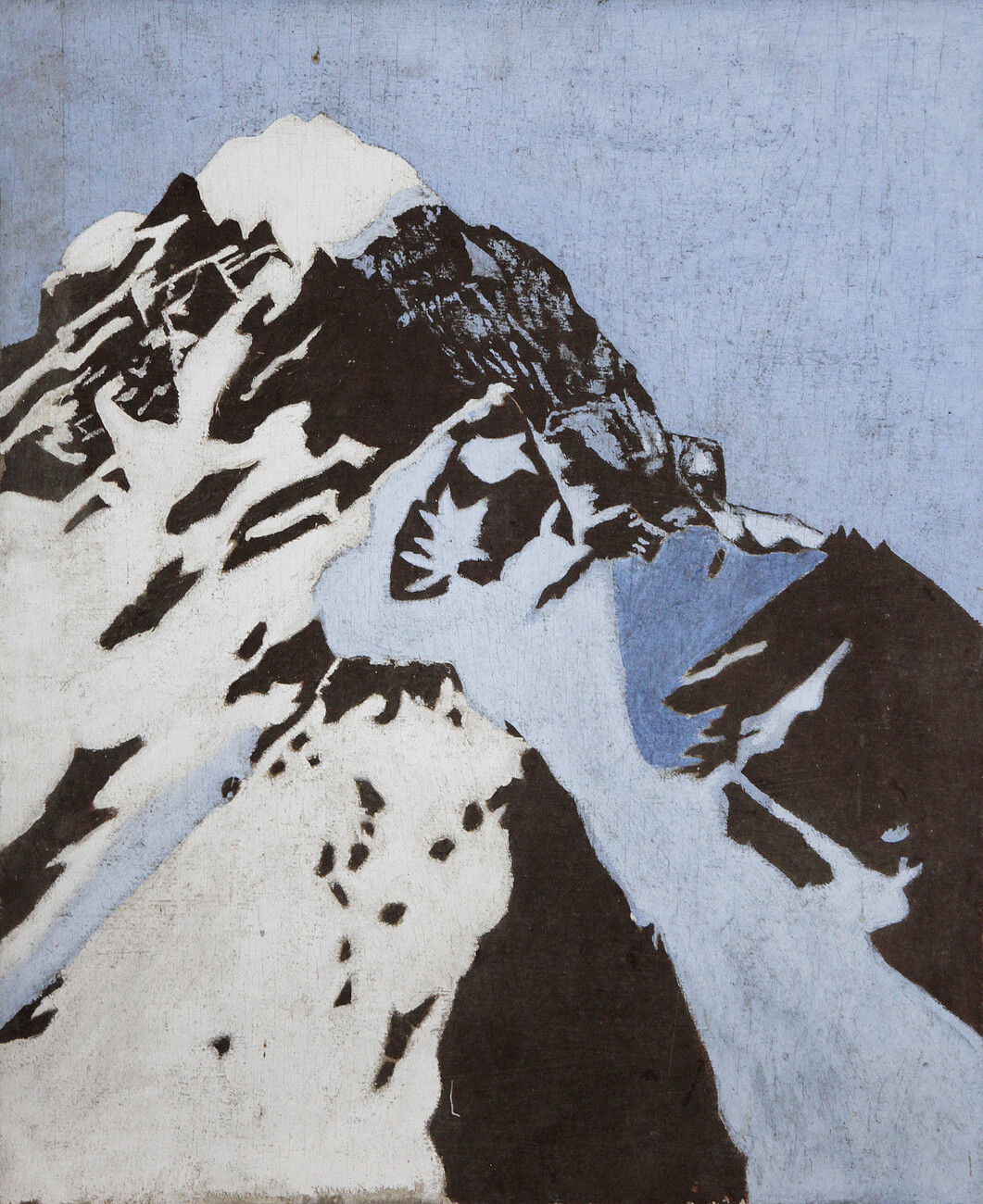
Photograph: Marte Visser.
It is important therefore not to assess his paintings from the point of view of professional standard; for, he neither paints for money nor for publicity. Painting is somewhat of a ritual with him, a seeking of bliss within. In his meditation he has vision of legendary gods and goddesses identified in the shape and forms of the mountains of Sikkim- in the changing colours of snow, rocks and foliage.
Yet, the Maharaja is a man of this age. His concern for the material well-being of his subjects is no less keen than his pursuit of spiritual attainment. Well versed in the cultural traditions of his land, legends, folk-lore, arts and crafts, he recognises the modernness of our time. It is no paradox then that in his art he chooses the modern media and technique-canvas, oil colours and the rest.
He had the irresistible urge for plastic expression at a fairly advanced age and he took to painting as late as 1950. He tried his hand in the traditional style of Tanka painting, but discarded the indigenous school in favour of the bolder technique of oil painting. Earlier studies in his adolescence-of black and white sketches and drawing at the St. Paul’s in Darjeeling- aided his efforts but principally his genius alone acquired the necessary technical grasp.
The most remarkable features of the paintings are the simplified registration of the contours and harmonious colour orchestration. The canvases breathe a clear and healthy mountain air. The pure atmosphere of the paintings has an elevating effect on you. The seemingly fantastic use of arbitrary green, grey, blue and brown accentuate an articulation which lifts the scene from being commonplace. The mystic appeal is further enhanced by the horizontal stripes of colour. The circles and other ritualistic shapes symbolise auspicious signs of peace and harmony.
On the January 24, 1961, Indian Prime Minister Nehru inaugurated an exhibition of some paintings of Chogyal Tashi Namgyal. This was the first and only formal exhibition the Chogyal would ever consent to. His Highness parked himself in Delhi with his family during the duration of the exhibition.
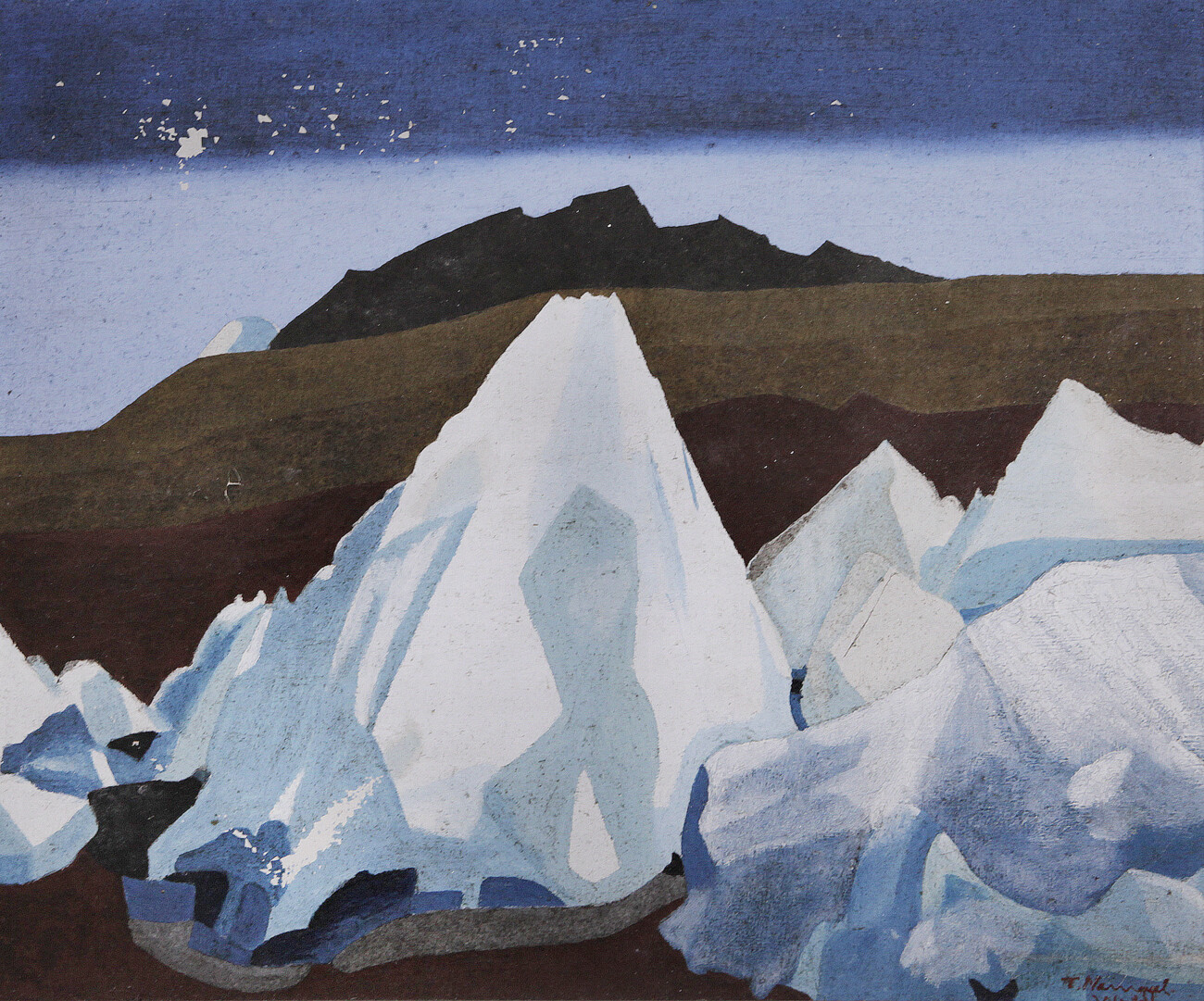
Photograph: Marte Visser.
Though Tashi Namgyal took up painting earnestly rather late in life, he still produced quite a few paintings. While he apparently gifted a few away, the bulk of his paintings, some twenty of them, were exhibited in New Delhi and were catalogued thus:
1. Chomo Yummo from Giaogang (Snow peaks in Northern Sikkim. Characterised by an arbitrary use of green for the sly against brown and white.)
2. Chomo Yummo from Giaogang (Snow peaks in Northern Sikkim. Change in the atmospheric mood indicated by this painting by grey sky.)
3. Gyamtso (Snow peaks stand out against the vision of a sky tinged in green.)
4. Lake South of Yeumtso (Snow-capped mountain on a turquoise lake. Horizontal bars in different colours symbolise Dakinis of the mountain- legends.)
5. Glacier source of Teesta, North of Pauhungri (The far stretching glacier that feeds the river Teesta.)
6. Lake Cholamo and Dongkhya La from North (A harmony in brown, grey and blue.)
7. View from Lungnag La (A shape in black emerges from harmonious grey.)
8. View from Lungnag La (A symphony in grey, green and blue.)
9. View up Naku chu (The sky in deep blue framing the landscape.)
10. The La (Time stands still, as it were, in a harmony of white and grey.)
11. Thebla (White peaks relieving the tonality of grey.)
12. Chomo Yummo from below Nakula (Deep browns contrasting quiet grey.)
13. The Tsabongma (A vision symbolising morning light.)
14. View up Valley E. of Langpo (Steel-blue of the sky, lifts up the brown and white of the foreground.)
15. Glacier head of Langpo Valley (A fantasy of white pyramidal valleys.)
16. Glacier head of Langpo Valley (Floating cloud forms matched by ice formations below.)
17. Glacier head of Langpo Valley (A forbidding wall of ice against the grey sky.)
18. Glacier head of Langpo Valley (Green sky, pink cloud and white cliffs combine into an enchanting decorative pattern.)
19. The Chorten Nima La (Rocky mountain silhouetted against the backdrop of blue.)
20. View looking S. From the Chorten Nyima La (A valley nestling between grey and black.)
Chogyal Tashi Namgyal passed away on December 2, 1963 after a long and fruitful reign of almost 50 years. Barely a decade later, in 1975, Sikkim became the 22nd state of India. So much of Sikkim’s landscape has changed, but his beloved mountains continue to enthral visitors to the state. His paintings today grace the walls of the homes of his grandchildren, and if you have soul, you may just hear the Devas and Devis speak to you from the canvases.
- Reprinted with permission from MARG (Sikkim: The Reinvention of Identities and Cultures edited by Prava Rai) MARG Vol.65 No:4 2014
Tenzin C. Tashi is a senior researcher and editor at the Namgyal Institute of Tibetology, Gangtok. She is a B. Tech (Electrical & Electronics Engineer) and an MBA (Marketing & International Business) but followed her heart into Sikkim- centric research.
She is also the Founder of the Sikkim Living History Project on Facebook.
4 comments on “THE ARTIST WITHIN”
Leave a Reply
Latest Posts
Latest Comments
No 'Comments_Widget_Plus_Widget' widget registered in this installation.


Thank you for this wonderful article. I can feel the gentleness in every word of it and also the glorious and ethereal past of Sikkim as well as its 11th Chogyal. I've read it repeatedly and still be able to breathe its beauty.
Useful article. worthy to read this one. I have seen some of the paintings of Maharaja in Private collection of Madam Hoplezum and also with Dr. Tendok Palzore Lepcha sir.
Went through the paintings. It is poignant to see these visuals. For those who lived in, or touched the late era of Sikkim, when it was as an independent kingdom, cannot ever forget those days of flowering, buoyant, very peaceful days!
Beautiful Article